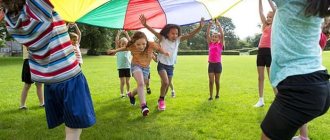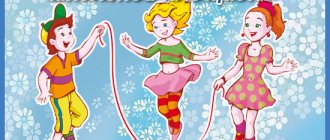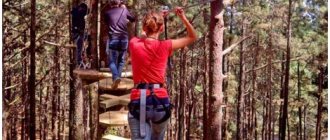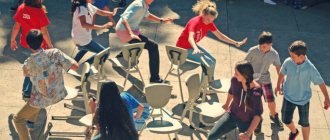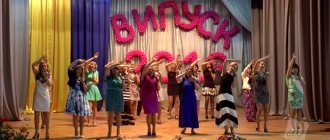Slicing
For this competition, you need to prepare a piece of music in advance (using the Internet and a computer). We take many, many different songs from cartoons and fairy tales, from films and popular performances, from the field of rap and rock, and so on. We cut each song and put it on top of each other. This way you will end up with one long melody with many excerpts from different songs. The passages should be approximately 5 seconds long. It’s better to take as many songs as possible. At the disco the presenter plays a super track. Schoolchildren dance and listen. When the track ends, the students remember and guess what songs were included in the track. Whoever raises his hand calls the song. For the correct answer, the participant receives a point. And at the end, whoever has the most points will win a prize.
When to do it?
The right time to hold the first dance competition is some time after the start of the banquet. First you need to create a certain atmosphere, amuse the guests and stir them up. Then it will be easier for them to overcome their embarrassment and get out on the dance floor. Note! Active and calm competitions must be alternated.
Everything related to dancing is active entertainment, so you should not force guests to dance if they have just been running or jumping. But after the table competitions it is quite possible to arrange dancing. You shouldn't hold dance competitions on an empty stomach; guests should at least have a little snack. But you shouldn’t pull them out from the table immediately after tasting the hot food. You can hold competitions after appetizers or some time after serving the main course , when guests are waiting for dessert. Also, a dance competition, group dance or flash mob can be a worthy end to the holiday.
Best Cancan
Schoolchildren are divided into teams with the same number of participants (approximately 6-7 people each). The participants of each team have their legs tied (one leg of one participant and the second of the second, the second leg of the second and one of the third, the second leg of the third and one of the fourth, and so on). For speed, you can simply wrap it with tape. The host turns on the music and the teams begin to dance the cancan dance. Whoever endures the entire dance and shows team spirit, and at the same time creativity in performance, will be the winner.
Set of games with hall 4
"Bambucha-hai!"
All the guys hold one hand up, in the shape of a duck’s beak, and the other below in the same shape (a popular dance movement) and say the following words: “bamboo-hai!”, after which the hands change - the one that was below rises up, and the one that was at the top goes down, the following words are pronounced: “bambucha hey!” After that, both hands need to be raised up, pronouncing the sound: “AHH!”, then we lower our hands down - “OOOO!” We clap our hands and shout - “IIIIII!” We wave our hands over our heads and shout: “GOOD MOOD COME!” or “HAPPY - HAPPY FOR THE CHILDREN’S REPUBLIC?! HAPPY - HAPPY! HURRAY! HURRAY! HURRAY!”
"A pizza hut."
This American game is called the name of the diner - “E Pizza Hut”. Before the game starts, the counselor agrees with the children how they will demonstrate pizza and Kentucky Fried Chicken. The following text is pronounced: E pizza hut (we depict pizza with circular movements of the hands), E pizza hut, Kentucky Fried Chicken End e pizza hut, E pizza hut, E pizza hut, Kentucky Fried Chicken End e pizza hut, McDonald's McDonald's Kentucky Fried Chicken, End e pizza hut. The next step is for the players to depict all this on an enlarged scale, and then vice versa - on a reduced scale.
"Roller coaster".
The audience performs movements for certain words. Going uphill - lean back and muffledly say: “oooh” Turn left - lean left and shout: “ah-ah” Turn right - lean to the right, sound: “o-o-o” We entered the water - words: “glug-glug” We accelerate - squealing and whistling.
"Achi - rachi - boxes."
The hall is divided into three groups. Some shout: “Achi”, others: “rachi”, others: “boxes”. First they rehearse with each half of the hall. And then who the presenter will point to. Afterwards, everyone shouts their words together 2–3 times. And the presenter says: “That’s how elephants sneeze!” If the third group shouts “cartilaginous”, then this means that the elephant is sneezing with a French accent.
"Lady".
The hall is divided into four parts. Everyone gets their words. 1: “In the bathhouse, the brooms are soaked.” 2: "The spindles are turned." 3: “But the sponge is not dried.” 4: “The lady is the lady, the lady is the madam.” The presenter “conducts” the hall, pointing first to the third, then to the third. Whoever he points to must pronounce his words. Before the start, words are rehearsed with each team.
"Brazil".
The players repeat the words and movements after the leader. “My grandmother lives in Brazil! She has a finger like this (Shows thumb, everyone repeats). My grandmother lives in Brazil. She has this finger (shows), and this mouth (curls her mouth, and everyone repeats). My grandmother lives in Brazil! She has this finger, this mouth (shows), these eyes (Goggles, everyone repeats).”
Each time more and more new ones are added to these phrases: these are the shoulders (right shoulder down, left shoulder up). She constantly jumps (shows). She screams: “Oh, how beautiful I am, why doesn’t anyone love me? (everyone screams).” After a pause, when the laughter subsides, the presenter says: “Like the grandmother, so are the grandchildren.”
“Everyone in this room is friends.”
Children perform actions based on the leader’s words: Everyone in this room is friends: me, you, he, she. Hug the neighbor on the right, hug the neighbor on the left, We are one family. Etc. with the words: Pinch the neighbor on the right... Caress the neighbor on the right... Kiss the neighbor on the right... Gradually you can speed up the pace and come up with new actions.
"Gnomes".
The hall is divided into two halves: “Petka” and Vaska.” The words of “Petek”: “Petka, I have a checkered shirt, I came to you kids to eat some candy.” Words from “Vasek”: “Vaska, I have polka dot pants, I came from a fairy tale, because I’m good.” The words are rehearsed with each half of the hall. Then the presenters say the following words: “On a high hill there stands a beautiful house, and in a beautiful house lives a cheerful gnome. Gnome, dwarf, what’s your name?” The answer follows from one half of the hall, then from the other. After this, both halves of the hall shout at the same time, who will outshout whom.
"Head, ramp."
Polish game. It is sung showing the places about which it is sung: “Head, ramp, knees, wrists; knees, wrists; head, ramp, knees, wrists, ears, mouth, eyes, nose.” The pace gets faster each time. (Ramp - shoulders).
"John-Brown-Boy."
John-Brown-Boy oiled his skis once... John-Brown-Boy oiled his skis once... John-Brown-Boy oiled his skis once... And went to the Caucasus... The song is learned with the children and sung. As you sing, the words (from the end of the phrase) are replaced by claps (the number of claps corresponds to the number of syllables). John-Brown-Boy smeared his skis with one clap John-Brown-Boy smeared his skis with a cotton, clap John-Brown-Boy smeared with a clap, clap, clap And so on...
"Rain."
Presenter: “Now we will learn our signature applause.” It is suggested that you repeat after him. “It started to rain lightly” - clap one finger on the palm. “The rain has become heavier” - clap two fingers on the palm. “The rain has become even heavier” - clap three fingers on the palm. “It started to rain heavily” - four fingers clap on the palm. “It’s starting to rain” - clap with your whole palm. After losing once, the host can offer to learn the ending of the game. When he waves his hand, the whole hall must say “yes” and the rain stops, silence sets in.
“Hole-hole: machine gun!”
It is necessary, repeating movements and words, to gradually speed up the pace. The words are as follows: “Hole-hole: machine gun! (hands depict shooting from a machine gun). Higher, higher, airplane! (the wings of an airplane are depicted). Bang, artillery! (one hand hits the other). The cavalry is galloping (one arm is waving above its head, depicting a saber). "Hooray!!!"
"Hippodrome".
Progress of the game: (B – leader, I – players). Q: “The horses are about to start.” And: they gradually speed up their “running”, hitting their knees with great frequency. B: “Barrier!” (double barrier). And: they raise both hands up once (twice), at the same time and sharply lower them B: “We are running along the pavement.” And: gradually beat themselves in the chest with their fists. B: “We’re running along the sand.” And: rubbing palm against palm. B: “We’re running through the water.” And: they alternately hit themselves on the cheeks with their palms. B: “Through the swamp.” And: they take their cheeks and pull them to the sides with sharp movements. Q: “The five-meter barrier.” And: they clap their hands five times. In: "Pani Tribune". The girls shout: “Spark!” In: "Pani Tribune". The young men shout: “Thunder!” Q: “Thunder breaks forth.” Boys: “Hey, hey!” Q: “The spark rushes forward.” Girls: “Hey, hey.” B: “The finish line is coming soon.” And: speed up the alternation of blows to the knees. B: “Finish!” And: they wipe away the sweat, imitating putting wreaths on the neck. Q: “We raise our right hand and place it on the head of the neighbor on the right, stroke it and say good words to him. We raise our left hand, place it on the left neighbor’s head, stroke it and say good words. We raise both hands and put them on our heads, saying: “Oh, what a great fellow I am!” Note: the presenter can alternate tasks and introduce new ones.
"How are you?".
The presenter asks a question, and the audience answers him by performing the appropriate movement: How are you living? - Like this! - Fist forward, thumbs up. How are you going? - Like this! - a movement that imitates walking. How are you running? - Like this! - running in place. Do you sleep at night? - Like this - palms under the cheeks. How do you get up? - Like this - get up from your chairs, arms up, stretch. Are you silent? - That's it - finger to mouth. Are you screaming? – That’s it – everyone screams loudly and stomps their feet. Gradually the pace can be accelerated.
"Bells".
The presenter divides the hall into 5 parts and distributes the words to each: 1.- “pancake-n-n” 2.- “half a pancake” 3.- “quarter of a pancake” 4.- “no pancakes, just sour cream” 5.- “pancakes” Each word is pronounced in a certain key and a certain size, and the tone varies from “pancake” to “pancakes”. Frequency from the whole part of “pancake” to 1/16 of “pancakes”. If you consistently maintain the tone and frequency, then the feeling of a bell ringing is created in the hall.
"Left foot, right hand."
The presenter divides the hall into 4 parts (if he uses 2 arms and 2 legs, if only 2 arms or 2 legs, then the hall is divided into 2 parts). Each part of the hall is responsible for some part of the body. When the presenter raises his right hand, the part of the audience that is responsible for the right hand claps, etc. A game of attention. The leader must confuse the children (cross his arms and legs, raise his hand from behind his back, etc.).
“The ball is flying, flying across the sky.”
(say words and show hand movements) A ball flies, flies across the sky. A ball flies across the sky, But we know that the ball will never reach the sky (gradually remove the words and replace them with hand movements)
"Monkeys."
(Leader - children) pronouncing the words, the participants depict what they are talking about. We are funny monkeys, We play too loud. We all clap our hands, we all stomp our feet, we puff out our cheeks, we jump on our toes. And we’ll even show each other our tongues, we’ll stick out our ears, our tail on the top of our heads, we’ll jump together towards the ceiling, we’ll raise our finger to our temple, we’ll open our mouths wider, we’ll make all the grimaces. As soon as I say the number 3, everyone freeze with grimaces.
“Nose – floor – ceiling.”
The presenter takes turns calling “nose”, “floor”, “ceiling”, pointing with his index finger. The players’ task is to carry out the leader’s tasks accurately (if “floor” is named, everyone must point to the floor). Same with other words. The presenter tries to confuse the players by pointing to something other than what he was told. For example, he said “nose” and pointed to the ceiling. A game for the most attentive.
“Nyeman is a daddy.”
The players stand in a circle, placing their hands on each other’s shoulders (you can just hold hands). The following words are learned: Nyeman, Nyeman, Nyeman, paparushka, Nyeman, Nyeman, Nyeman, papasan, Nyeman, Nyeman, Nyeman, paparushka, Nyeman, Nyeman, Nyeman, papasan, O-o-o-o-o-o-o- oh, yes! When pronouncing the first and third lines, participants move with side steps to the right; pronouncing the second and fourth - to the left. “O-o-o-o-o-o-o-o-o,” he sings to the tune of “Katyusha” with bends back and forth. “Yes!” - performed with a characteristic movement of the arm and leg. Then the game is repeated from the beginning with acceleration.
"Observatory".
— Do you know what an observatory is? Would you like to visit there? Yes? Well, then let's go (stomp). We come to the observatory, and there are beautiful curtains, we open them like this: Zipper, zipper (we show it at the same time). They pulled it apart, and there was a telescope. We move it like this: U - y - y. We looked into it, nothing was visible. The glass is dirty. We take a rag and wipe it: sh – sh – sh. We looked, still nothing was visible, we didn’t adjust the focus. We lean forward, put our right hand to our temple, close our right eye and do this: bzy - y-y, bzy - y - y. And everyone saw the star: oh-oh-oh. And many, many stars: chpok, chpok, chpok. And there are comets flying there: fallen ones; meteorites: vysh. Herds of flying saucers fly by: hoo-hoo. And there is a huge Mir station: oh-ho-ho. And a little astronaut falls out of there: ooh-ooh (sad). And he is immediately saved by an alien ambulance: fau-fau-fau. And she brought him to earth: wow. An astronaut (a player from the audience) comes out and says: “Who is meeting me here?” All in chorus: “We.” He asks: “What are you doing here?” We answer: “We’re playing at the observatory, do you want to join us?” (The game continues until he says no). The game progresses from simple to complex, adding movement each time.
"Granny's Shopping"
The presenter says a line, and the children repeat it in chorus: “Grandma bought herself a chicken……….” chicken grain by grain cluck-tah-tah...………. (shows with his hands how the chicken pecks) - Grandma bought herself a duck………. Ducky tyuh-tyuh-tyuh………. (shows with his hands how a duck swims) – Chicken, grain by grain, cluck-tah-tah………. duck tyuh-tyuh-tyuh………. – Grandma bought herself a turkey……….. Turkey coattails………. (for the word coattails - hand to the right, bulldozers - to the left) (repeat about chicken, duck, turkey) - Grandma bought herself a kitty………. And Kisulya meow-meow………. (repeat from the beginning) – Grandma bought herself a dog………. Little dog woof-woof………. (repeat from the beginning) – Grandma bought herself a little cow………. Little cow of flour-flour………. (repeat from the beginning) – Grandma bought herself a pig………. Piglet oinks-oinks………. (repeat from the beginning) – Grandma bought herself a TV………. TV time-facts………. Announcer la-la-la………. (repeat from the beginning)
“One flower, two flowers.”
All in chorus and with movements. Once a flower, two flowers. Hedgehogs, hedgehogs Forged, forged Scissors, scissors Running in place, running in place. Bunnies, bunnies, Come on, together, come on together, Girls (girls shout) Boys (boys shout). Who's louder?
“Guys, stand up.”
The presenter offers to carry out his commands only if he pronounces the address “guys”. For example: “Guys, clap your hands,” everyone should clap. “Now stomp,” no one should stomp, since the address “guys” was not said.
"Volume control".
The presenter depicts the volume control with his hand. The maximum raised hand means maximum noise. A hand down means silence. The counselor raises his hand up, lowers it down, and the players make sounds at the appropriate volume.
"Fish"
Presenter: “A game for attention. Imagine that my left hand is the sea (makes a wave-like movement), and my right hand is a fish (with my right palm I depict a fish that swims, wriggling). When the fish swims out of the sea, that is, the right hand rises above the left hand, then you clap your hands. So, let's begin!". The leader initially makes slow movements. Then he introduces deceptive movements, speeds up the pace, giving him a standing ovation.
"Firework".
The host offers to arrange a fireworks display in the hall. Two people are invited to the stage. One gets the role of a matchbox, which stands at the right wing, close to the edge of the stage. The second is the role of a match. Standing in the middle of the stage, the match will have to proudly walk to the box and, striking its head on the box, light up. The presenter invites a spectator in bright red clothes, who will play the role of a light. The next 4 spectators become the wick. Lined up, they stand in the middle of the stage. Next, the viewer is invited to play the role of a cannon. Positioned at the left wing, the cannon should loudly say “bang”. And finally, 5 to 8 spectators in bright clothes are invited from the hall. They crouch in front of the stage in a circle and after the cannon signal they stand up with the words “tili-tili”, and the audience applauds. After the rehearsal there is a fireworks display. The presenter comments on what is happening: “The proud match walks towards the box and, striking its head on the box, it lights up, a light appears, a light appears. A match with a spark moves towards the wick. The light runs along the wick to the cannon. The gun fires. The fireworks light up to the applause of the spectators.
"Salami".
All players stand in a circle. The counselor invites everyone to learn the following words: “Tram-pum-pam, Tram-pum-pam, Guli-guli-guli-guli, Tram-pam-pam, Salami, salami, Guli-guli-guli-guli, Tram-pam- pam, Simultaneously with the words, the following movements are performed: tram-pam-pam - the players slap their knees 3 times; guli-guli - the players scratch their chins with one hand and scratch their heads with the other; salami, salami - alternately (first one then the other) bend their arms at the elbow, bringing the hand to the shoulder. After the participants have learned the text, they are asked to make the “Tram-pum-pam” movement at the neighbor on the right. The game repeats itself. Then the neighbor on the right makes the movements “Trum-pum-pum” and “Guli-guli-guli-guli.” Next, “Tram-pum-pam” is done by the neighbor on the right, and “Guli-guli” by the neighbor on the left. We always make salami at home.
"Fairy tale".
The presenter comes up with a fairy tale scenario (any characters, any actions, it all depends on your imagination).
The hall is divided into parts, the number of which is directly proportional to the number of heroes of the fairy tale. Each hero performs some kind of movement (for example, Ivan Tsarevich: hand from top to bottom and the words: “Eh-uh”, princess: hands at the seams, shoulders walk from side to side and the words: “hee-hee-hee” ). Next, the presenter tells a fairy tale. When a hero is named, the part of the audience that is responsible for him performs a movement, and the words are pronounced in chorus.
"Titanic".
It is proposed to stage a new film "Titanic". Presenter: “Let's go on a sea voyage on the Titanic.” To do this, two people are invited to the stage. They will be on board the Titanic. Then another actor is invited. He gets the role of the boat. The sides hold hands, and the boat hangs in their hands. The bow of the ship should be decorated with a female figure, a beautiful girl is needed. A girl comes out. Then two tall people are invited and asked to be on the ship. The ship is built, but not equipped. It is very important not to forget the flare. A little girl is invited to play this role. Able to make a loud, piercing cry. Two actors in white are invited to play the role of the iceberg. He gets in the way of the ship. Finally, a couple is invited and plays the role of lovers. Lovers on the bow of the ship depict a scene from the movie “Titanic” (flying on the bow of a ship over the ocean). He: “Trust me” (trust me). She: “I trust you” (I believe you). Presenter: “But then the ship crashes into an iceberg and splits in half (the sides uncouple the hands, the boat falls into the water). There is panic on the ship (spectators scream). Rats flee the ship (spectators stomp their feet). A signal flare takes off. Signal flare: “HELP! HELP!” Rocket jumps out of his chair and screams. Presenter: “And our lovers are saved on a boat. A happy ending. Everyone kisses."
“Tut-tu-chi-chi.”
The presenter says a line, and the children answer: TU - TU - CHI - CHI I have a train It takes me along the rails It has a pipe and a stove And a magic ring We will leave from the station It has four halls We will go to Paris Or maybe closer Here the spring rain began to fall and our train got stuck. We are standing in a huge puddle. We have no time for Paris here.
“You are my triangular cap.”
You are my triangular cap, My triangular cap, If you are not triangular, Then you are not my cap. Each word is replaced by a gesture gradually, and the pace quickens.
“The deer has a big house.”
The deer has a big house. He stands, looks out the window. A little bunny runs past and wiggles his ears. Knock, knock, open the door, there is an angry hunter in the forest. Bunny, bunny, come on in. Give me your bunny paw. At the same time, movements are shown. The pace gradually quickens.
"Hippopotamus bite."
The presenter says the line, and the children repeat it along with the movements. I was bitten by a hippopotamus. Out of fear, I climbed a tree. And here I am, and my hand is there. I was bitten by a hippopotamus. I was bitten by a hippopotamus Out of fear, I climbed a tree And now I’m here And the other hand is there I was bitten by a hippopotamus (and so on about all parts of the body) This chant is learned in advance and sung by everyone together.
"Football".
The hall is divided into two halves. If the presenter raises one hand up, then one half of the hall shouts in unison: “Goal.” If he raises his other hand up, then the other half of the hall shouts: “Past.” If two hands are raised, everyone shouts together: “barbell.” After the rehearsal, the presenter begins the game, trying to confuse the players.
"Hey, mamba-mamba, hey."
The plot of the game begins with the fact that two presenters on stage start an argument about whose half of the hall is better. To resolve the dispute, one of the presenters invites his half of the audience to shout: “Hey, mamba-mamba, hey.” The second presenter invites his half of the audience to shout this phrase much louder and clap their hands together. Then the presenters take turns adding different actions to the existing ones. After the agreed action, one of them offers to make peace, after which the last phrase is shouted by everyone together.
Before performing actions, the presenters need to talk through their sequence. The chain of actions should not be made too long.
"Teapot."
Teapot, lid. Lid, knob. A lump, a hole... Steam comes from the hole. There's steam coming out, there's a hole. A hole, a lump... A lump, a lid. Lid, teapot. The song is learned with children and sung, accompanying the words with hand movements: teapot - palms parallel to each other lid - palm of the right hand - lump with the lid - fist hole - fingers in a ring (OK sign) steam flows - the index finger makes circles in increasing order. As the singing progresses, the words are replaced by the word - LA-LA-LA and hand movements.
"Chika - boom."
The presenter asks you to repeat words and movements after him. For the first word - clap your hands, for the second - clap your knees, then the movements are repeated. First, the leader says the line, and then all the players repeat it, not forgetting to make the movements. Lyrics: Chika - boom - cool song, Let's sing it all together, If you need cool noise, Sing chika - boom with us. I sing boom, chica - boom, I sing boom, chica - boom, I sing boom, chica - raka, chika - raka, chika - raka, chika - boom. O - e, A - a, Once again.
Wild dances
Schoolchildren are divided into teams of approximately 5 people (the more teams, the better). Each team gets a forfeit, which indicates the animal (monkey, antelope, lion, crocodile, giraffe, etc.). Then they turn on the music and the teams dance their wild dances (the team that got the forfeit with a crocodile dances the dance of crocodiles, depicting these animals as believably as possible, the team that got the forfeit with a monkey dances the monkey dance, and so on). Based on the results of applause, the best team is chosen - the wild animal dance team.
Dance "vinaigrette"
This entertainment option will be a wonderful opportunity to rally guests and slowly invite them to the dance floor.
The bravest ones will start, but gradually those who modestly sit on the sidelines will join
The dance “vinaigrette” allows the guests to get excited and at the same time does not focus attention on any individual person, putting him in an awkward position. In order to make such a dance competition , you will need cuts from various melodies, which can be both popular and have survived the times. You can take music of different styles - from twist, disco and “gypsy” to fiery Latin American rumba, lambada and tango.
Wedding dance competition
This simple yet fun wedding dance competition will help guests have fun and feel braver. You can also come up with a prize for the one who dances the most rhythmically and can show a variety of dance moves .
In the box
Time to take a break from dancing and de-escalate the situation. Schoolchildren are divided into teams with the same number of participants (approximately 6 people each). The members of each team stand in separate rows. The first participants stand in a box (any cardboard box of the appropriate size, you can ask for them in the store). At the command “start”, the first participants move as quickly as possible in their box to the finish mark, then deftly jump out of it, grab the box and run back, leave the box for the second participant and stand at the end of the team. Then the second participants deftly jump into the box and move to the finish mark, deftly jump out of it, grab the box and back. The team that will cover the distance in the box back and forth faster than the rest with the entire number of participants will be the winner.
How to prepare?
To hold dance competitions at a wedding you will need the following:
- spacious room;
- musical equipment and audio recordings;
- good lighting.
Selecting songs for competitions is an art in itself. It is better to prepare several dozen different compositions in advance in order to be able to select music to suit the current mood of the guests. You need to be able to very clearly determine the time period for turning it on, so that there are no awkward pauses. The music should be handled by someone who can handle the equipment well . It's best to hire a professional DJ.
Guests should also be given enough space to move around freely. You should not conduct such entertainment near tables with food. At least 3 square meters must be allocated for dancing. This is enough for a small group of dancing guests. Dance competitions are selected depending on the size of the room. The more spacious it is, the more opportunities there are for holding them. floor should be well lit. This creates the right atmosphere, because the dance part is always in the spotlight. During dance events, you can turn on disco lighting, play with spotlights or arrange a laser show.

